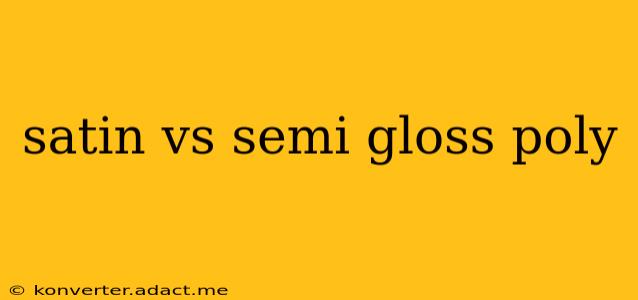Choosing between satin and semi-gloss polyurethane can feel overwhelming. Both offer durable protection for your woodworking projects, but their visual characteristics and practical applications differ significantly. This guide will help you understand the key distinctions, enabling you to make an informed decision for your next project.
What is Satin Polyurethane?
Satin polyurethane offers a subtle sheen, falling somewhere between a flat (matte) and glossy finish. It's characterized by a soft, understated luster that minimizes imperfections while still providing a noticeable shine. This makes it a popular choice for many applications.
Advantages of Satin Polyurethane:
- Hides imperfections: The slightly reflective surface effectively masks minor flaws in the wood grain or finish application.
- Versatile appearance: Its understated sheen complements a wide range of furniture styles and woodworking projects.
- Easy to clean: Satin polyurethane offers good resistance to moisture and dirt, making cleaning relatively easy.
What is Semi-Gloss Polyurethane?
Semi-gloss polyurethane boasts a more pronounced shine than satin, but it's not as reflective as a full gloss finish. This medium sheen offers a balance between durability and a less-pronounced shine, making it suitable for both high-traffic and visually demanding areas.
Advantages of Semi-Gloss Polyurethane:
- More durable than satin: It generally offers slightly better resistance to scratches and wear and tear.
- Easier to clean than satin: The smoother, more reflective surface makes it easier to wipe clean.
- More vibrant color: The higher gloss enhances the wood's natural color and grain.
Satin vs. Semi-Gloss: Which is Right for Me?
The best choice depends entirely on your project and personal preference. Consider these factors:
Aesthetic Preference:
- Subtle look: Satin is ideal if you prefer a more understated, natural-looking finish.
- More shine: Choose semi-gloss if you want a more pronounced, polished look.
Application Location:
- High-traffic areas: Semi-gloss's increased durability makes it a better choice for furniture that experiences frequent use, such as kitchen tables or chairs.
- Less demanding areas: Satin is suitable for furniture pieces or projects in lower-traffic areas, such as a bedroom dresser or decorative shelf.
Wood type and imperfections:
- Imperfect wood: Satin's ability to hide imperfections makes it a good choice for wood with knots or other blemishes.
- Perfect wood: Semi-gloss will better showcase the beauty of flawless wood.
Which is easier to apply?
Both satin and semi-gloss polyurethane are relatively easy to apply, provided you follow the manufacturer's instructions. However, achieving a perfectly smooth finish with semi-gloss requires slightly more attention to detail due to its higher gloss level, which magnifies any imperfections.
Does one offer better protection?
Both offer excellent protection against moisture and wear. While semi-gloss is often considered slightly more durable due to its harder finish, the difference is marginal in most applications. Proper application is key to maximizing the protection of either finish.
What are the best uses for each?
Satin polyurethane: Ideal for furniture, cabinetry, trim, and other interior woodworking projects where a subtle shine is desired.
Semi-gloss polyurethane: Best suited for high-traffic areas such as kitchen tables, chairs, and flooring where durability is a priority.
Ultimately, the decision between satin and semi-gloss polyurethane comes down to personal preference and the specific needs of your project. Carefully consider the factors outlined above to make the best choice for your next woodworking endeavor. Remember to always read and follow the manufacturer's instructions for optimal results.
